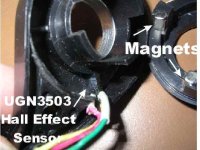Hugues
1 kW
Hi guys,
I'm looking for a not too complicated way of changing the way my throttle behaves (hall effect). You can see in the chart attached the Voltage in relation to the throttle position, for simplicity i measured the voltage at 8 different positions between closed and fully opened. That's the blue line. The red line is what I would like to achieve instead. There are 2 things that bother me with my current setting:
- the twist angle is too wide from zero to fully open. I don't like to twist that much, and also, as throttle power is not quite legal here on a bike, i would like it to become a little more "discreet" when i twist it.
- second thing is that there is a nice burst of power by the end, the blue line clearly shows it, and i would like the output to be more linear, or even a bit curved, slowing down towards the end.
So the output i would like is the red line. (motor starts spinning at around 1.5 V)
Is there a not too complicated way of achieving this ? I checked inside the throttle to see if i can bring the 2 magnets closer in order to reduce the twist angle, but these are nicely glued in place and the risk of breaking them is high.
Any simple electronics on the signal line could do the trick ?

thanks a lot,
I'm looking for a not too complicated way of changing the way my throttle behaves (hall effect). You can see in the chart attached the Voltage in relation to the throttle position, for simplicity i measured the voltage at 8 different positions between closed and fully opened. That's the blue line. The red line is what I would like to achieve instead. There are 2 things that bother me with my current setting:
- the twist angle is too wide from zero to fully open. I don't like to twist that much, and also, as throttle power is not quite legal here on a bike, i would like it to become a little more "discreet" when i twist it.
- second thing is that there is a nice burst of power by the end, the blue line clearly shows it, and i would like the output to be more linear, or even a bit curved, slowing down towards the end.
So the output i would like is the red line. (motor starts spinning at around 1.5 V)
Is there a not too complicated way of achieving this ? I checked inside the throttle to see if i can bring the 2 magnets closer in order to reduce the twist angle, but these are nicely glued in place and the risk of breaking them is high.
Any simple electronics on the signal line could do the trick ?

thanks a lot,



